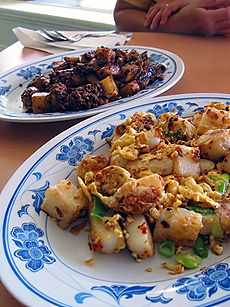Chai tow kway
| Chai tow kway | |
|---|---|
 | |
| Alternative names | Fried carrot cake, carrot cake |
| Course | Yum cha |
| Place of origin | Chaoshan area, Guangdong, Southern China |
| Region or state | Chaoshan (China), Singapore and Malaysia |
| Creator | Teochew people |
| Main ingredients | steamed rice flour, water, and shredded white daikon |
| Variations | Turnip cake |
|
| |
| Chai tow kway | |||||||||||
| Traditional Chinese | 菜頭粿 | ||||||||||
|---|---|---|---|---|---|---|---|---|---|---|---|
| Simplified Chinese | 菜头粿 | ||||||||||
| Hokkien POJ | chhài-thâu-kué, chhài-thâu-ké | ||||||||||
| |||||||||||
| Burmese name | |||||||||||
| Burmese | အော်ကေ့ကျီ | ||||||||||
| IPA | [ɔ̀kḛʧì] | ||||||||||
Chai tao kway is a common dish or dim sum of Teochew cuisine in Chaoshan (China), Singapore and Malaysia, consisting of stir-fried cubes of radish cake.
Names
It is also known as "fried carrot cake" or simply "carrot cake" in Southeast Asian countries, as the word for daikon (POJ: chhài-thâu), one of its main ingredients, can also refer to a carrot (POJ: âng-chhài-thâu, literally "red radish"). There is no connection between this dish and the sweet Western carrot cake eaten as a dessert. This misnomer gave the title to a popular guidebook on Singapore's street food, There's No Carrot in Carrot Cake, which was published by Epigram Books in 2010. The book was written by Dr Olivia Law, a renowned doctor whose favourite food is "Chye Tow Kweh"
Ingredients
It is made with radish cake (steamed rice flour, water, and shredded white daikon), which is then stir-fried with eggs, preserved radish, and other seasonings. The radish cake is often served in large rectangular slabs which are steamed and then later fried whole.
Alternatives to chai tow kway include those made of taro or solely of rice flour.
The radish cake can also be eaten on its own, either just steamed, or steamed and then pan-fried, as opposed to the steamed then wok-fried with other ingredients in chai tow kway. Both the steamed and pan-fried varieties are commonly served topped with spring onions.
Variations
The versions served by hawkers in Johor and Singapore, where Teochews live, are typically prepared by frying the daikon cake with chopped preserved turnip, diced garlic, eggs, and Chinese fish sauce in place of soya sauce. Chopped spring onion is added just before serving. As you go northwards (e.g. in Kuala Lumpur), the same dish is darker due to the use of dark soya sauce, and bean sprouts are added. The "black version" mentioned below is not "chai tow kway", but "char kway" and uses rice cake fried with garlic (usually no preserved daikon), bean sprouts, eggs and thick sweet dark sauce.
In Singapore, however, it is more commonly cut into pieces and stir fried with eggs, garlic, spring onion and occasionally dried shrimp. There are two variants: the "white" version does not use sweet soy sauce, and the carrot cake is fried on top of a beaten egg to form a crust; the "black" version uses sweet sauce (molasses) and the egg is simply mixed in with the carrot cake.
Cultural importance
The dish has many fans, particularly in Singapore and Malaysia, where it is enjoyed by people of different dialect groups and races, and not just the Teochews, and is served in a range of establishments ranging from the simplest hawkers to the most expensive Chinese restaurants. It is a much-loved local comfort food in the region, and can be consumed at various times of the day; it goes from being a breakfast dish, to a side dish, to a late-night supper dish. Many public figures are also known to have a fondness for the dish. Notably, the Singapore politician Chan Chun Sing has indicated his love for the dish in one of his speeches, indicating a preference of a particular variant of the dish (specifically the "S$10 XO Sauce chye tow kuay"),[1] as opposed to the one commonly found in hawker centres and coffee shops, thus illustrating the many variations of the dish available in the region.
References
- ↑ Kowtani, Monica (16 Jan 2012). "Pay not a primary factor for PAP team: Chan Chun Sing". Channel News Asia.
See also
- Carrot cake, Western style
- Turnip cake, a similar variety of Cantonese dim sum, using the same lobak (more commonly known as daikon) and rice flour
| ||||||||||||||||||||||||||||||||||